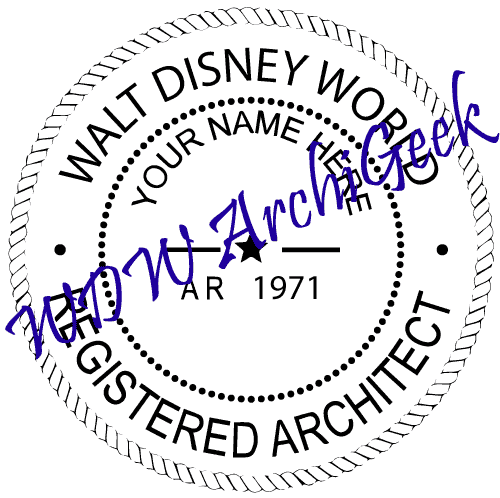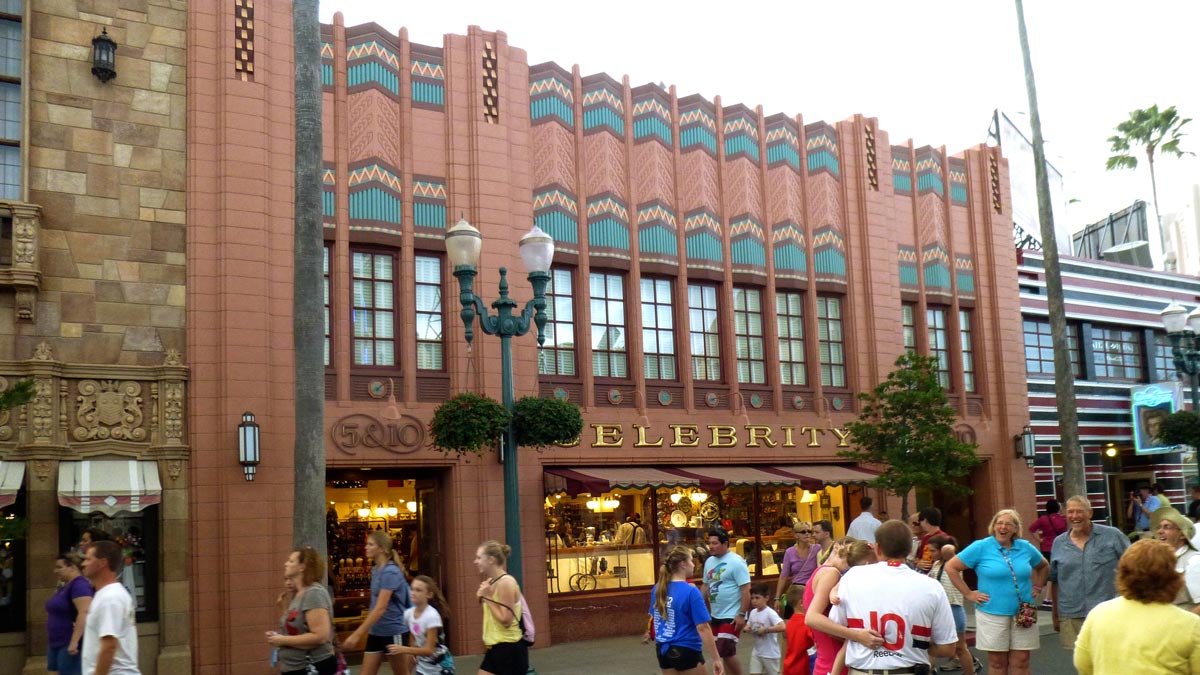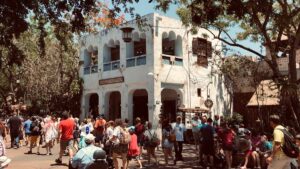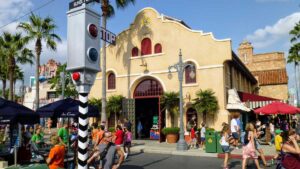I’m not sure why, but Celebrity 5 & 10 is one of the buildings that I always think of when I think of the architecture on Hollywood Boulevard at Disney World’s Hollywood Studios. It’s certainly not a flashy façade. And it’s not trying to stand out. It’s a soldier building: it lives to serve. Celebrity 5 & 10 simply does a great job of forming a street wall for the “indoor room” that is Hollywood Boulevard.
Where are we? We’re back to our series on the architecture of Hollywood Boulevard. We’ve been making our way roughly northeast from the intersection with Sunset Boulevard. It’s maybe not the most memorable architecture at Walt Disney World along this stretch, but it sets the theme of the land amazingly well. Our subject building is the one in gold below. You can find previous posts on the adjacent Head to Toe (here), Trolley Car Cafe (here), and Hollywood Junction (here).
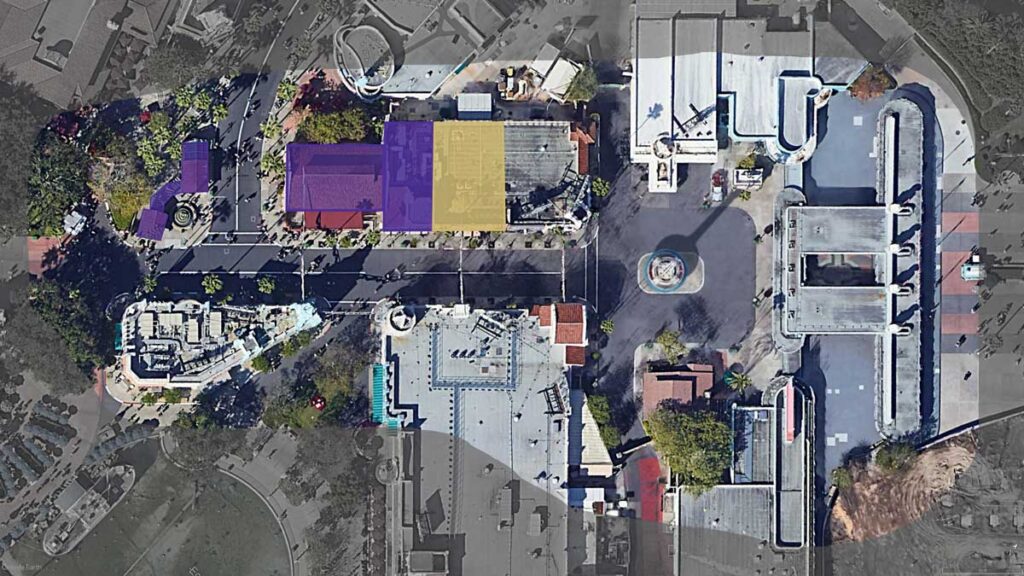
Speaking of the theme, the sub-land of Hollywood Boulevard at Disney’s Hollywood Studios is set in 1930s Hollywood. Specifically, it paints a picture of a glorified, idealized version of Hollywood from that era, as portrayed in movies. The buildings on Hollywood Boulevard are all strongly inspired from real Los Angeles architecture of that decade. So, a lot of Art Deco, Streamline Moderne, Spanish Colonial and Mission Revival, and Craftsman architecture populate the land.
How it Fits in Hollywood Boulevard
Celebrity 5 & 10 sits in the center of the block on the north side of Hollywood Boulevard. Like many of the façades on the street, it doesn’t do any urban design gymnastics attempting to stand out. It simply holds the street wall. But it’s not a wall flower either. It rewards anyone who notices it as they walk by, with beautiful Art Deco detailing.
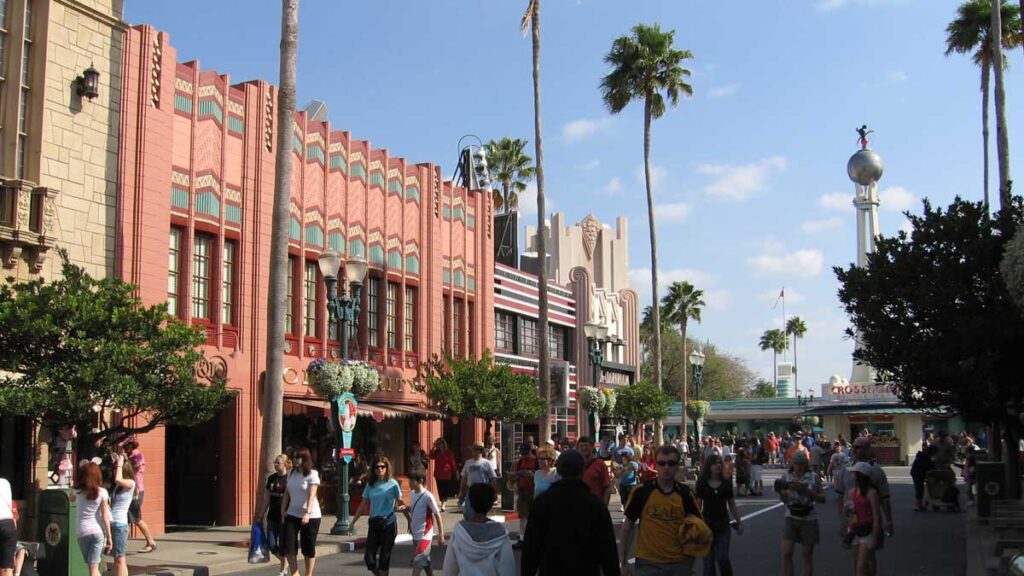
Looking at the image above and below, you can see how the façade helps the north side of the street crescendo from the shorter two-story facades, closer to the entrance, up to the tower of the Head to Toe building. The parapet at the roofline steps up to the tower, building by building, and Celebrity 5 & 10 plays the middle man… or step.
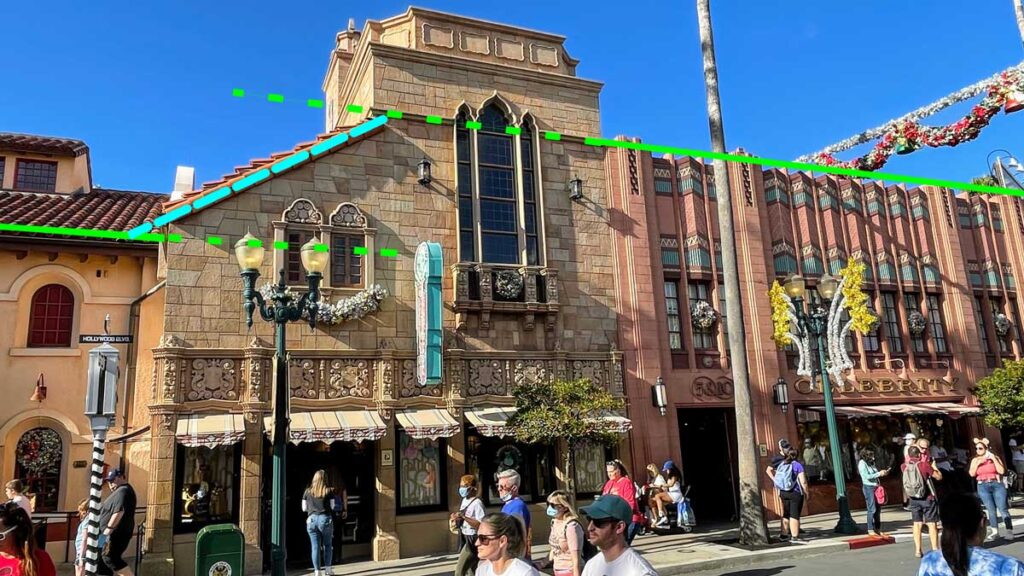
Note how the façade is still contextually relating to the adjacent buildings. The tops of the second-story windows align with the shorter building to the east’s windows. And, as mentioned in this post, and as diagrammed above, the parapet of Celebrity 5 & 10 is aligned with a stone band on the tower to the west. It’s the connective tissue on the north side of the street!
Façade Design
Well, it may be connective tissue, but that doesn’t mean that Celebrity 5 & 10’s façade lacks a strong diagram of its own. It is a symmetrical – in other words: mirrored about the center – design. And the overall scheme, in its simplest form, of the building is an A | B | A pattern. While there are horizontal elements, the architecture is mostly vertically-oriented.
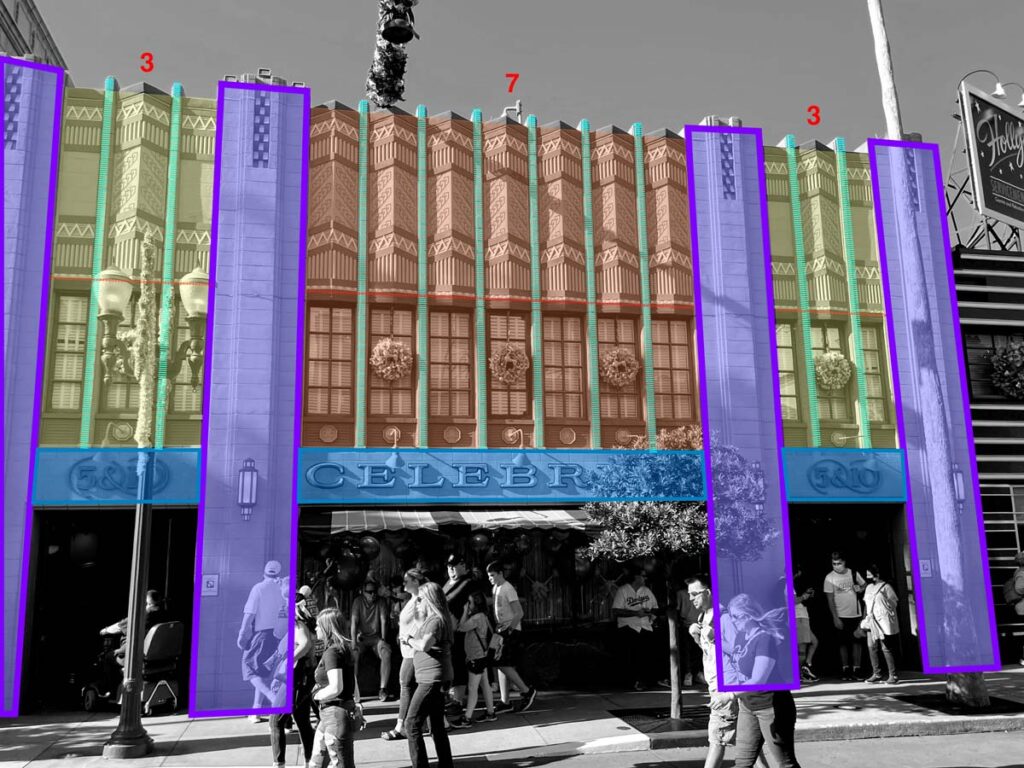
The outer bays of the building are the same, and consist of three smaller vertical divisions over top of a large opening which serves as the entrance to the store. The upper stories of the wider central bay are divided into seven sub-bays, and sit atop a wide awninged storefront. Four identical piers divide up the bays and also form the outside corners of the façade. These piers host narrower projecting pilasters that contain the light sconces on the building and emphasize the verticality.
The lower retail story of the building is separated from the upper stories by a tall signage band that sits in the same plane as the four large piers. It helps define a strong base to the building, which is a hallmark of classical, and classically-based architectural styles. While the portion above the first floor is certainly two stories in height, only one story contains windows. And if its just a parapet wall, its one of the tallest in the contiguous United States. So, I’m not sure what happens up in that third floor, but it’s happening in the dark. That incredibly detailed third floor helps form a top to the façade design… also a classical architectural principle.
Architecture Style
But this building is not a classical or neo-classical building. It is an Art Deco design – which does apply classical principles into its buildings. Now, I’m sure you didn’t come to this site to get a history lesson on Art Deco (for the ten of you reading this,) but I’ll give you a quick rundown.
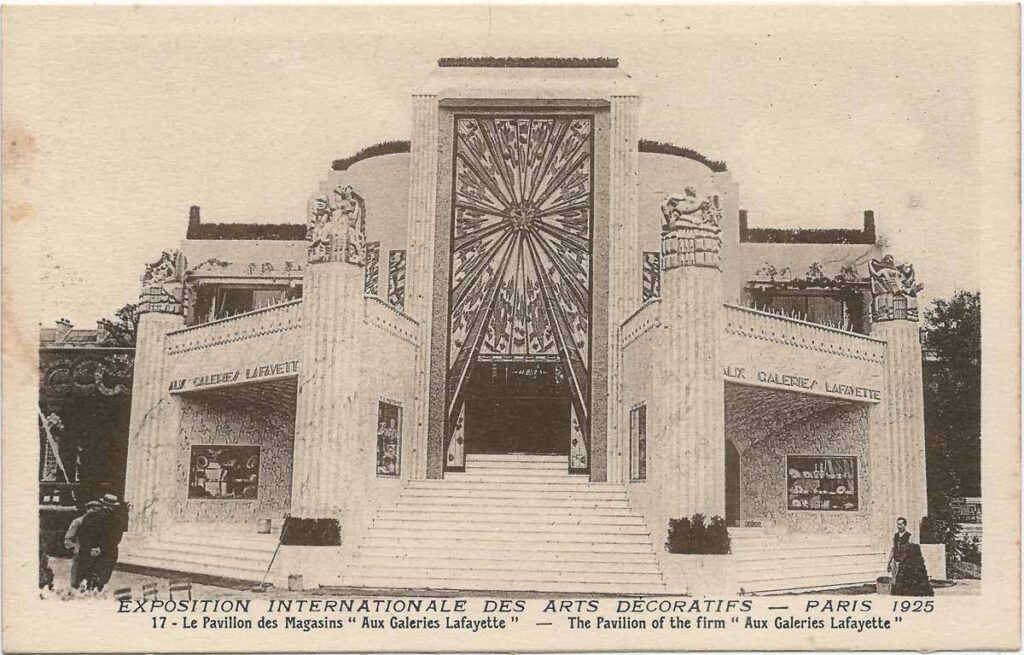
public domain
WARNING – History Lesson
The style got its name after the 1925 Exposition Internationale des arts decoratifs et industriels modernes in Paris, presented there as the Style Moderne. The style is based on streamlined, machined forms, combined with exotic Pre-Columbian, Egyptian, and Asian art (in part because of a popular interest in archaeology), mixed with shiny metals and warm natural materials. Art Deco, essentially, is a combination of modern progressive thinking and manmade craftsmanship, along with a huge dose of luxury. It’s a style based, in part, on the Art Nouveau style before it, but bolder and more geometric than its predecessor. Throughout the late 1920s and 1930s, Art Deco was prominent throughout the United States, as well as Europe. But after that, due to World War II’s impact, Art Deco became a rarer and rarer sight as other more functional modern architectural styles took over.
While it is one of the most recognizable architectural styles, there is a wide range of looks when it comes to Art Deco buildings. Most people think of the late 1930s Streamline Moderne variety when they think of Art Deco – and we’ll get to that in a few posts because it exists in the architecture on Hollywood Boulevard at Disney World. But, Art Deco is much more diverse than that.
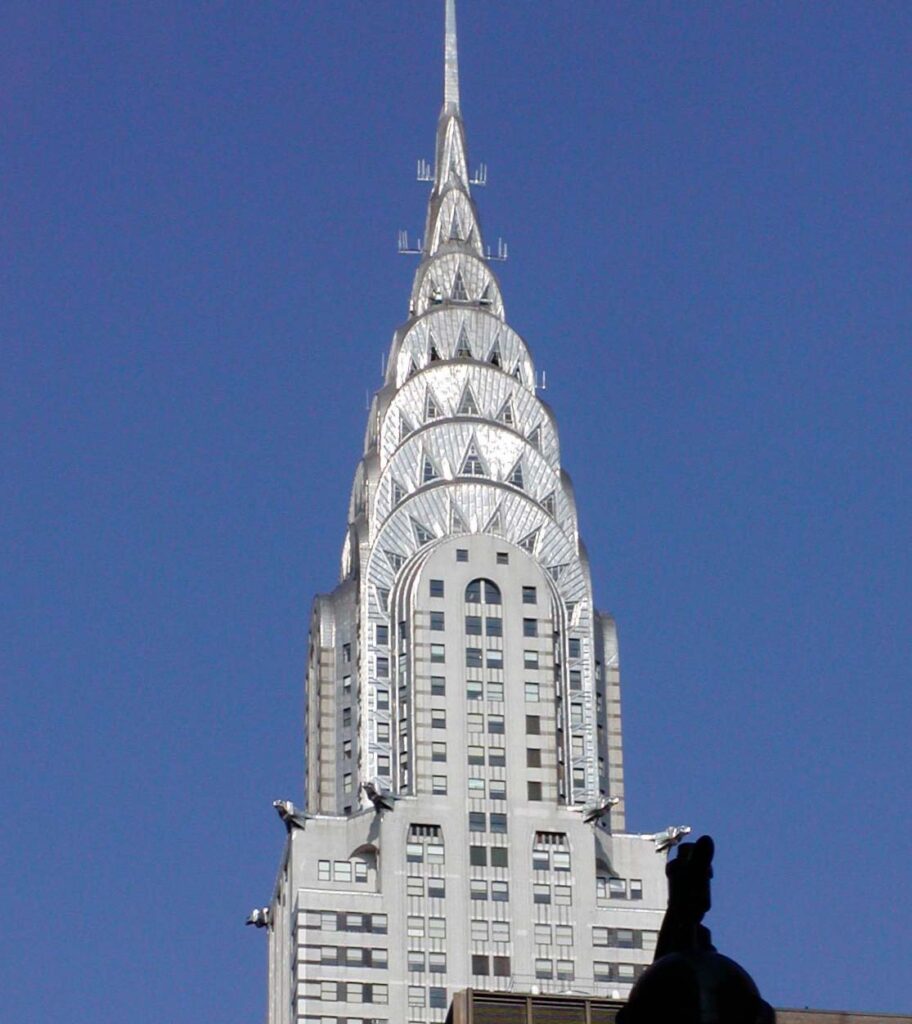
Art Deco Examples
Maybe the most famous example in the U.S. is the 1,046 feet tall Chrysler Building, in Manhattan, NY. Completed in 1930, its distinctive stainless steel crown and spire are the most memorable elements. But its gargoyles, its hubcap and fender brick motifs, and its Ancient Egyptian-inspired elevator lobbies and cabs also are signature Art Deco examples, as seen in the images below:
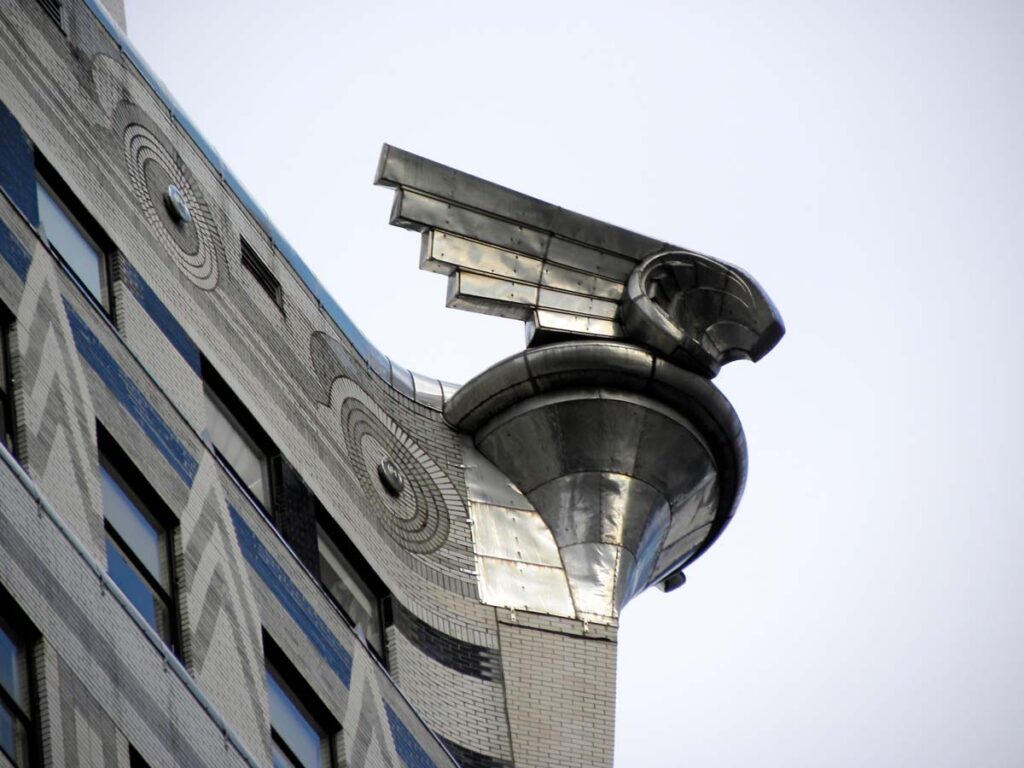
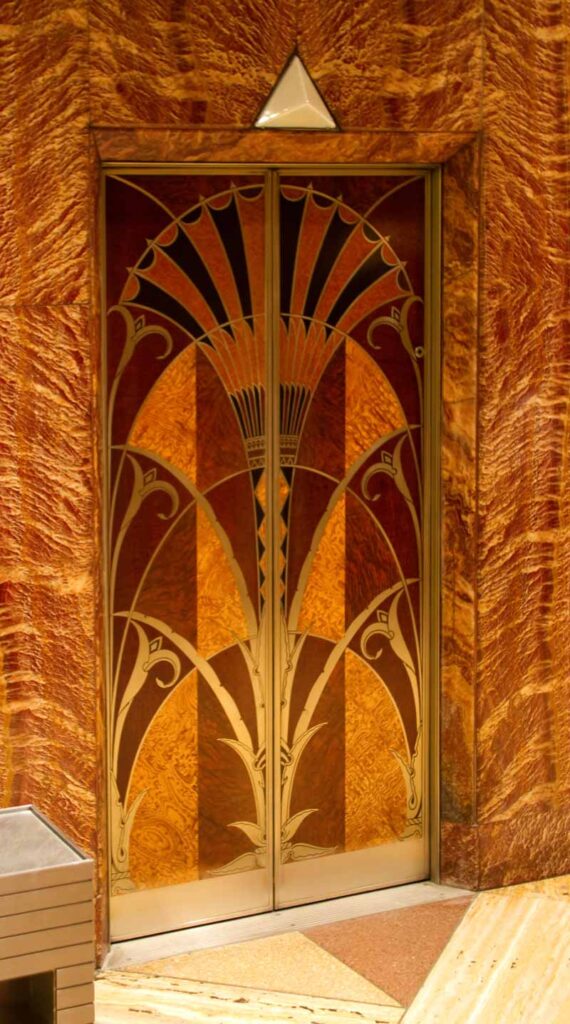
Other Art Deco Examples
Some other signature examples of Art Deco buildings in America are:
Cincinnati Union Terminal, 1933
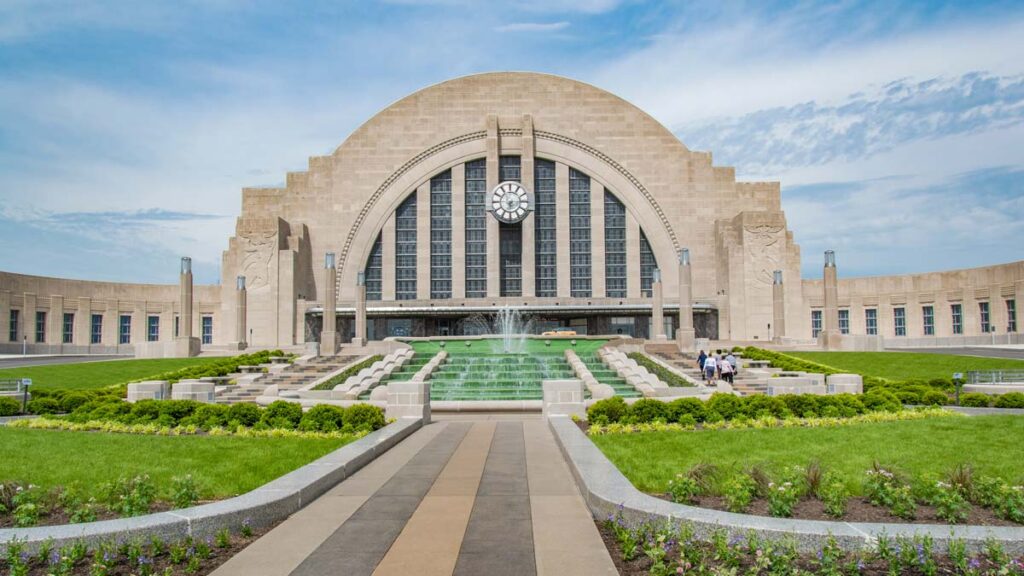
Buffalo City Hall, 1930
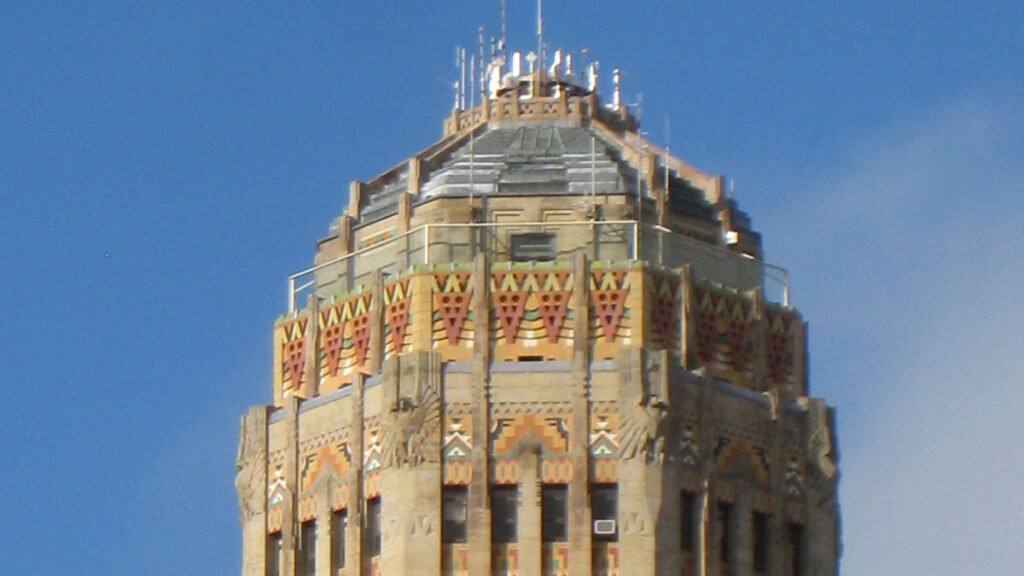
Louisiana State Capitol, Baton Rouge, LA, 1932
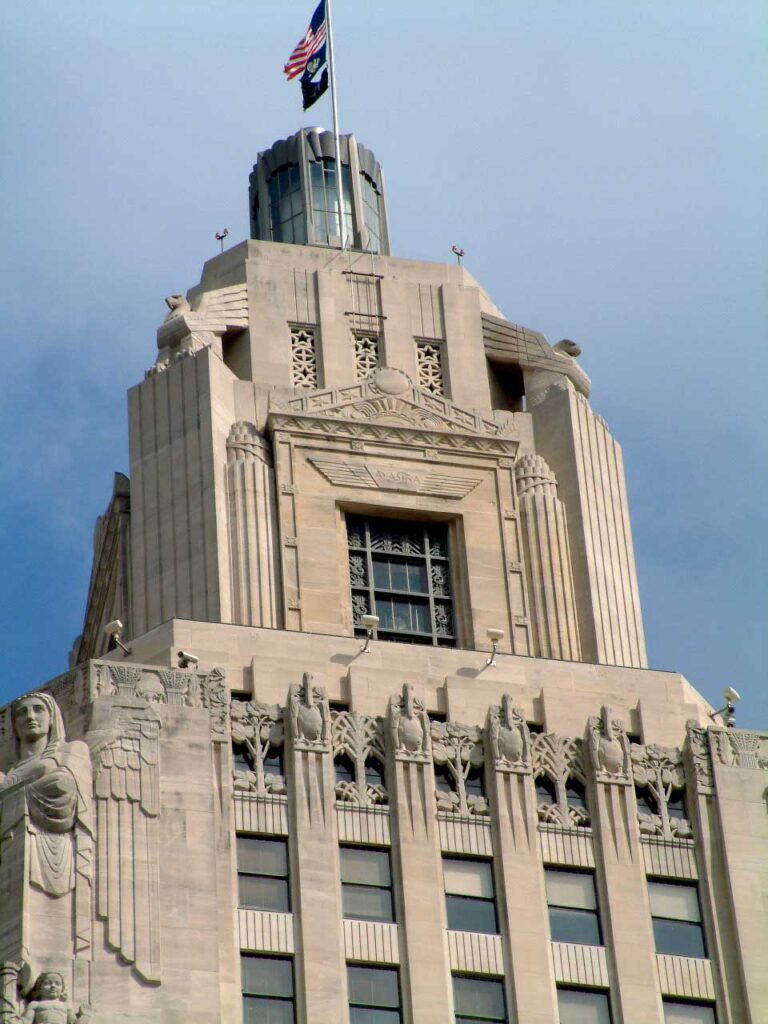
KiMo Theater, Albuquerque, NM, 1927
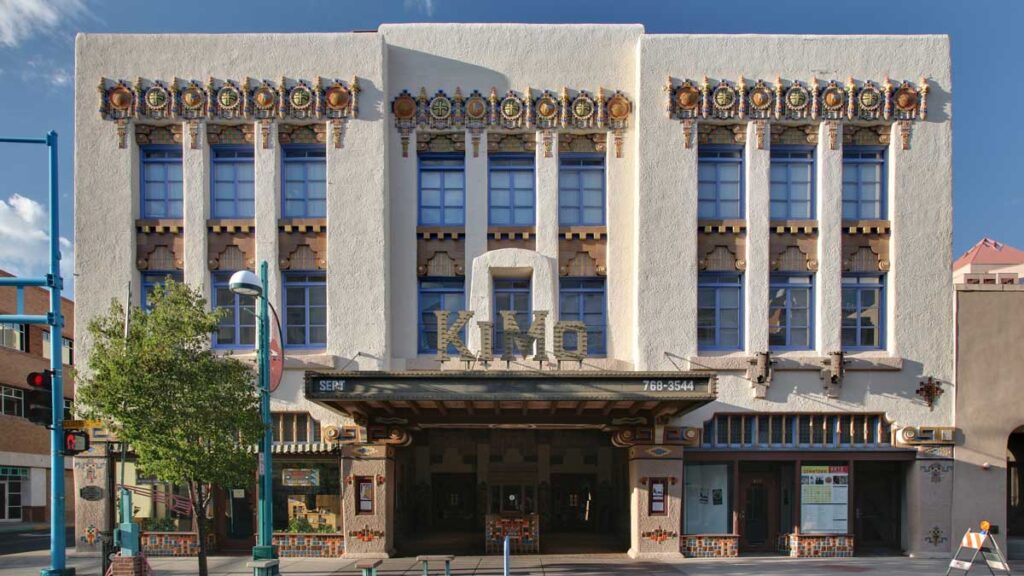
Bullocks Wilshire, Los Angeles, CA, 1929
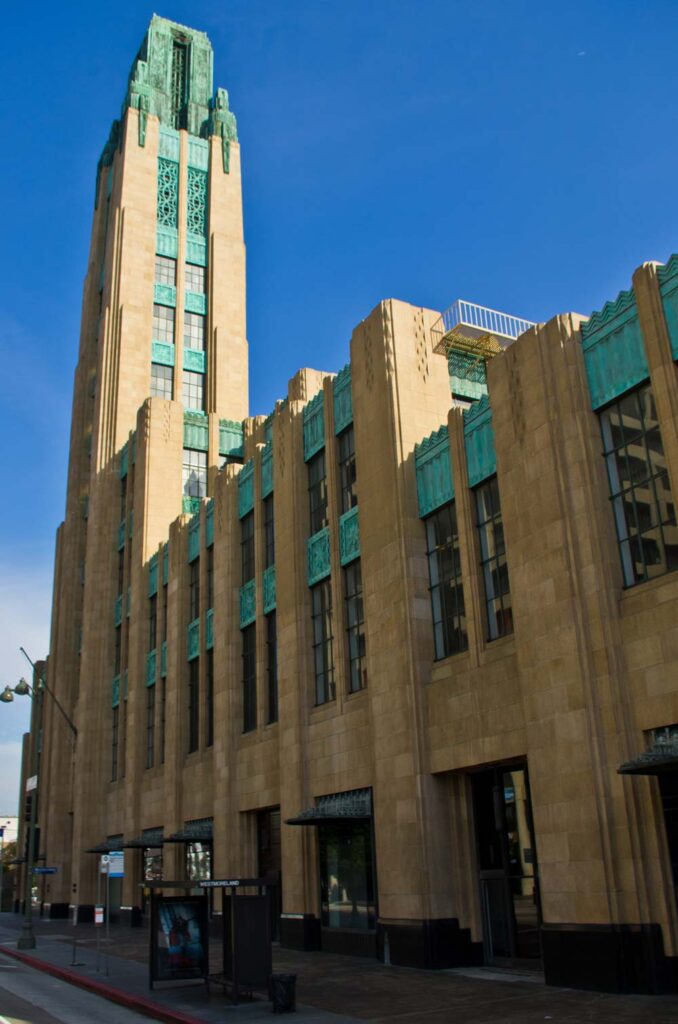
Historical Precedent
You might start to see a bit of Celebrity 5 & 10 DNA in the last couple of Art Deco examples above especially, with the rhythmic bays and the inset decorative panels. Well, our subject building on Disney World’s Hollywood Boulevard in Hollywood Studios is actually based on a specific building in Los Angeles.
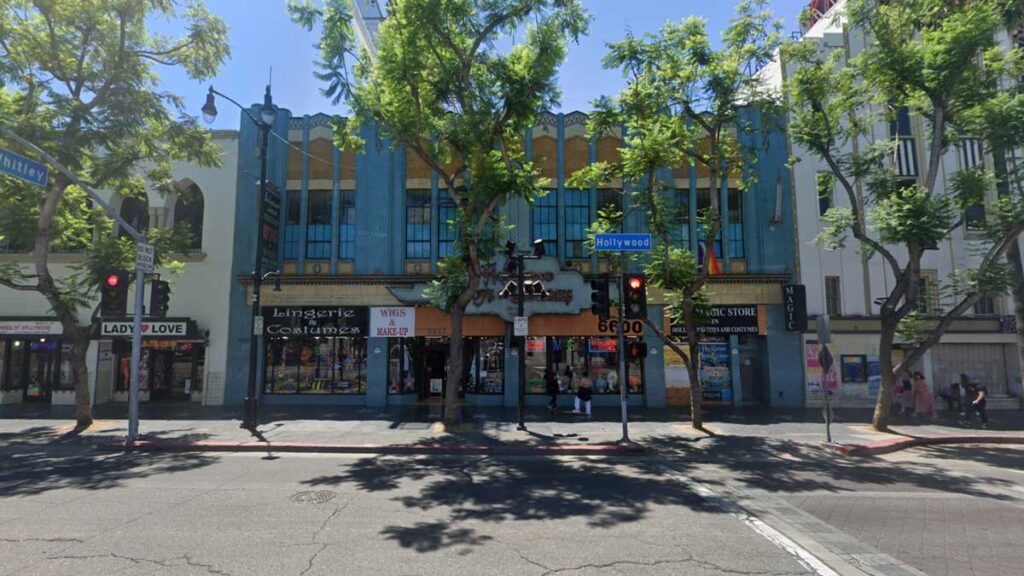
The J.J. Newberry Building was a “five-and-dime” store constructed in 1928 on the ACTUAL Hollywood Boulevard in Los Angeles. It still stands today, as seen from the google street-view image above. Celebrity 5 & 10 is amazingly faithful to its precedent.
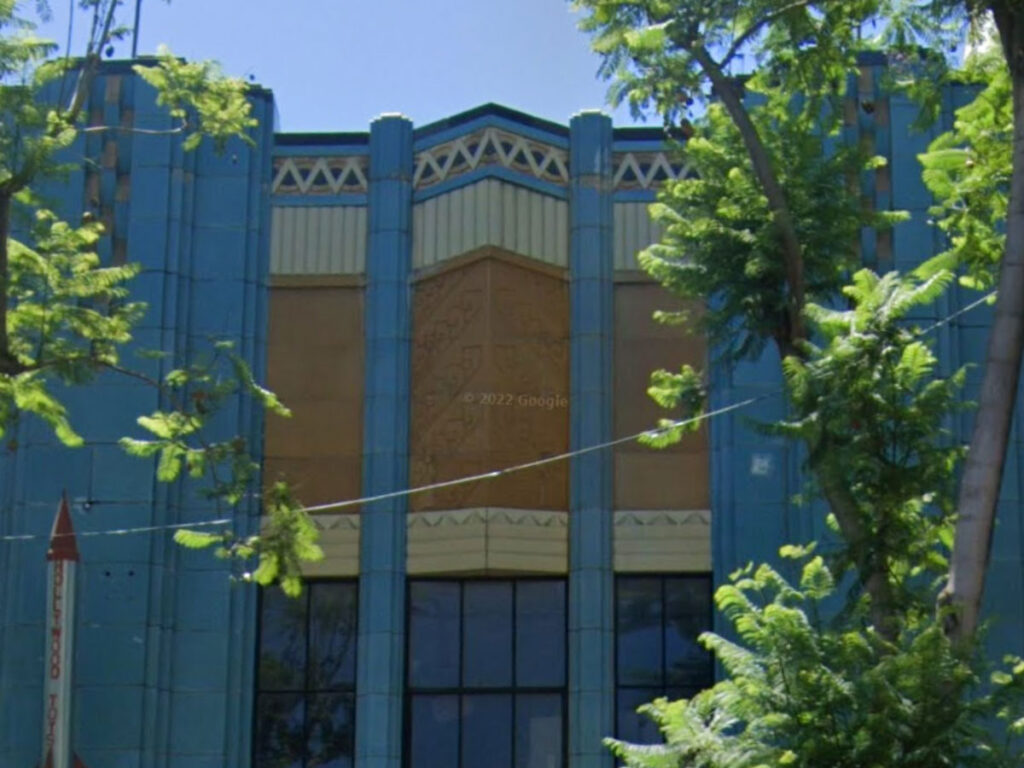
The bay scheme is exactly the same, along with the Egyptian detailing in the infill panels. What’s different? Well, the tall stone band above the retail storefront on the J.J. Newberry Building is much more prominent, and in fact interrupts the major vertical piers. Celebrity 5 & 10’s signage band blends in more and is submissive to the strong vertical elements. I think that’s it for the differences… …Ok, obviously the COLOR is also very different. The glazed turquoise terra cotta tiles of the original were deemed, by Disney Imagineers, to not work well on the Hollywood Boulevard in The Studios. Instead, they made the Egyptian-inspired panels turquoise and chose the rose-colored terra cotta for the rest of the façade.
Details
Alright, that’s enough Between-the-World-Wars-Architectural-History-in-America class. You’re welcome. Let’s end with getting back to Hollywood Boulevard at Disney World and looking at some of the details of the architecture.
Storefront and Sign and Sconce
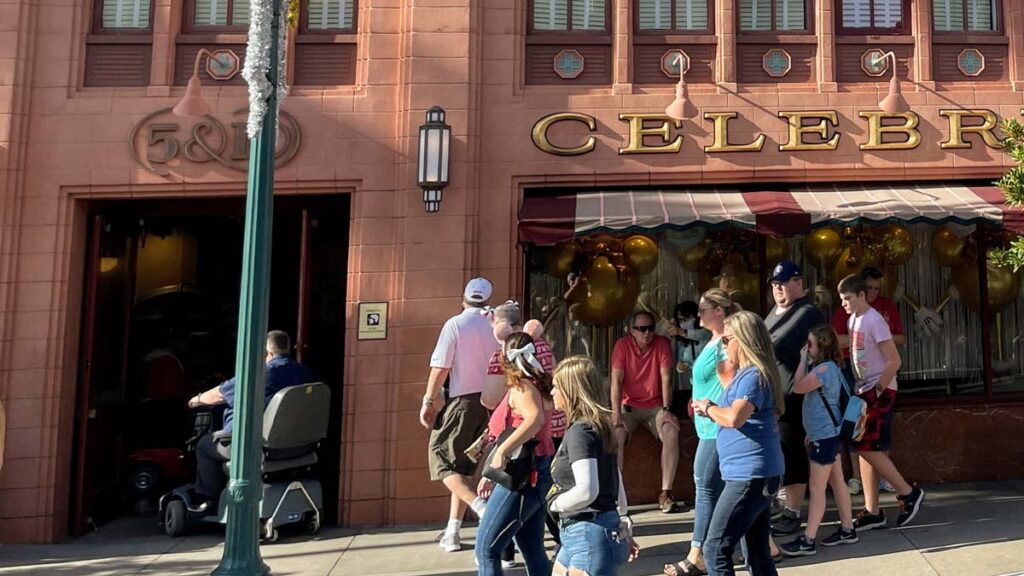
Here you see how the vertical piers and the pilasters continue uninterrupted to the ground. The storefront bay on the left is one of the two entrances to the store, whereas the central portion of the ground floor (on the right) is a display window with a fabric awning. Above the glass of the first floor is that horizontal zone that hosts the signage. Above the two entries, an elegant “5 & 10” logo (with a VERY sinuous ampersand) marks their centers. Both are a dull gold, almost bronze material.
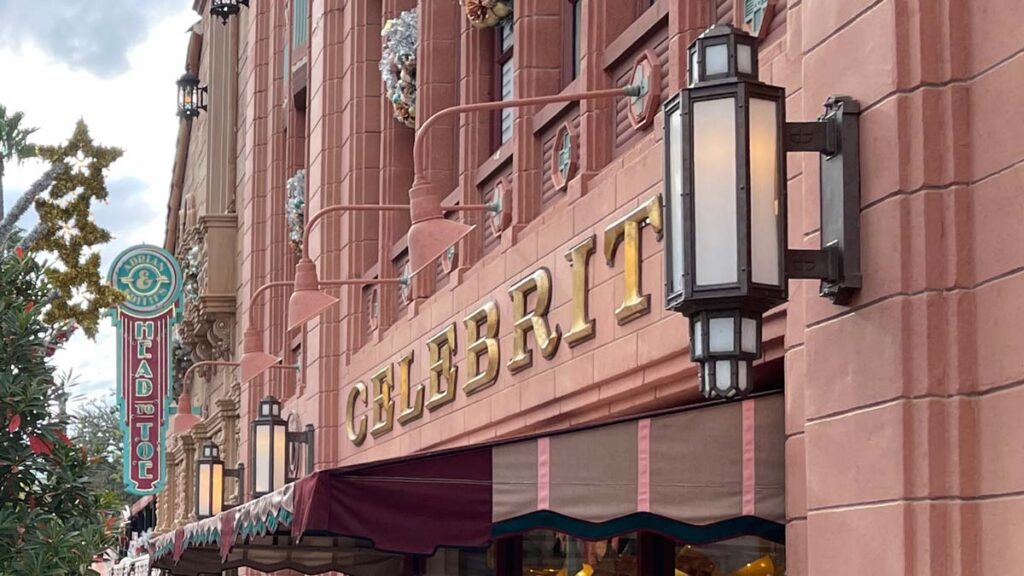
Bright, gold, individual 3-D letters spell out “CELEBRITY” in the center bay. Large, beautiful, eight-sided bronze sconces mark the intersections of the horizontal sign band and the vertical piers that define the three architectural bays. The frosted glass of the lamps causes all surfaces of the light fixture to glow at night, making a bigger impact on the façade.
I’m not sure whether the exterior material of the building is a terra cotta tile, or simply a stucco / exterior plaster of sorts meant to mimic terra cotta. Either way, it’s not glazed and turquoise like its source material. But, the rose color of the façade does play nicely with the gold letters of the sign.
Panel Design
The design of the architectural panels across the top of the façade form an abstracted cornice of sorts. But more than that, they’re just so exotic and gorgeous!
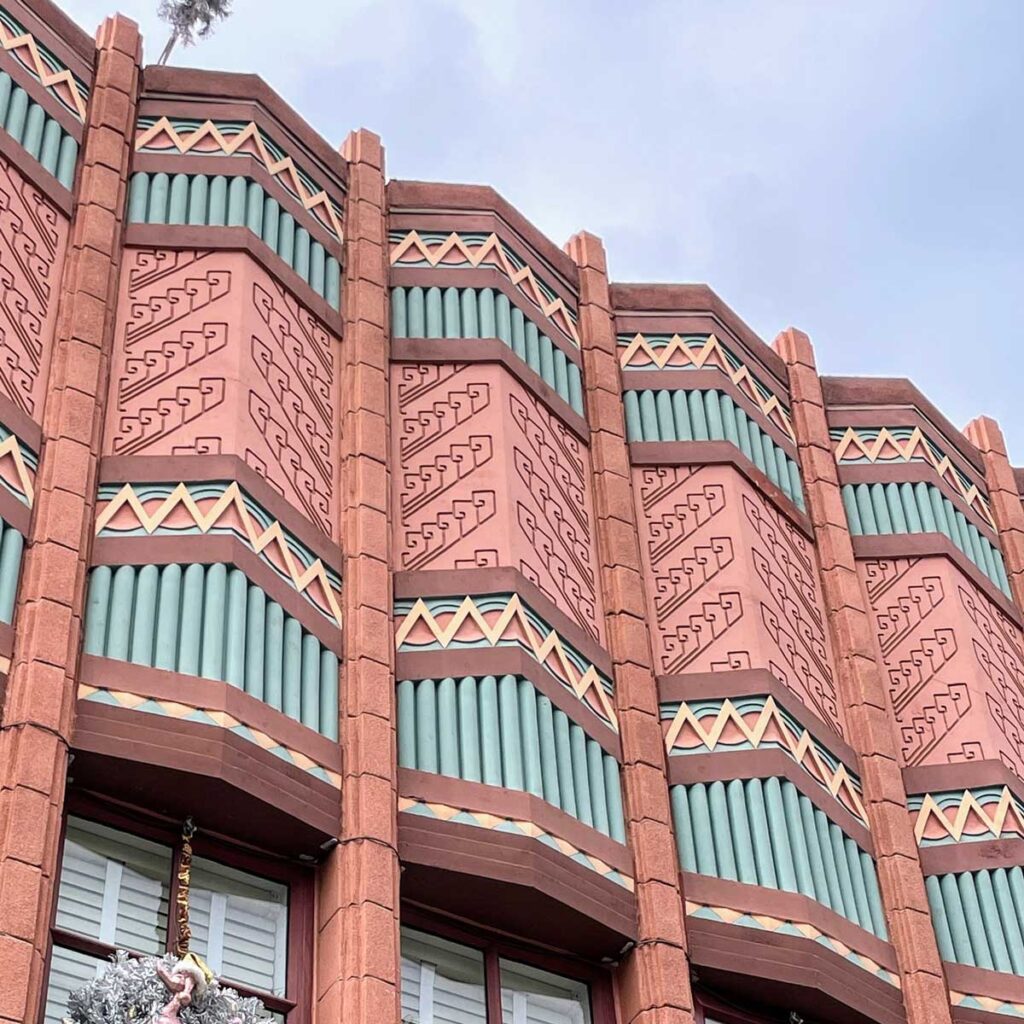
Because they’re so high up above eye-level, they’re likely passed over by most guests. But the quirky, brightly colored, Egyptian-styled terra-cotta designs are exquisite. Note that each panel accordions out slightly, which adds a fascinating depth to the architecture. I have no idea what the imagery in the panel is meant to be. The fluted turquoise areas maybe represent reeds in the Nile? The yellow zig-zags maybe are invoking the Great Pyramids? Is the pattern on the rose-colored field supposed to be grain of some kind? Maybe one of you knows. If so, drop the answer in the comments.
Sign on the Side / Angled Bricks / Chevron Trick
I want to point out a few details in the image below. First, check out the stenciled sign on the side wall over top of the adjacent building. Forgive the quality of the picture – it says, “Celebrity 5 & 10”. It’s essentially a cheap billboard, that a proprietor in the 1920s might have painted to make use of an otherwise blank wall. This part of the architecture faces the main entrance of Disney World’s Hollywood Studios, so it makes sense to place an advertisement up there.
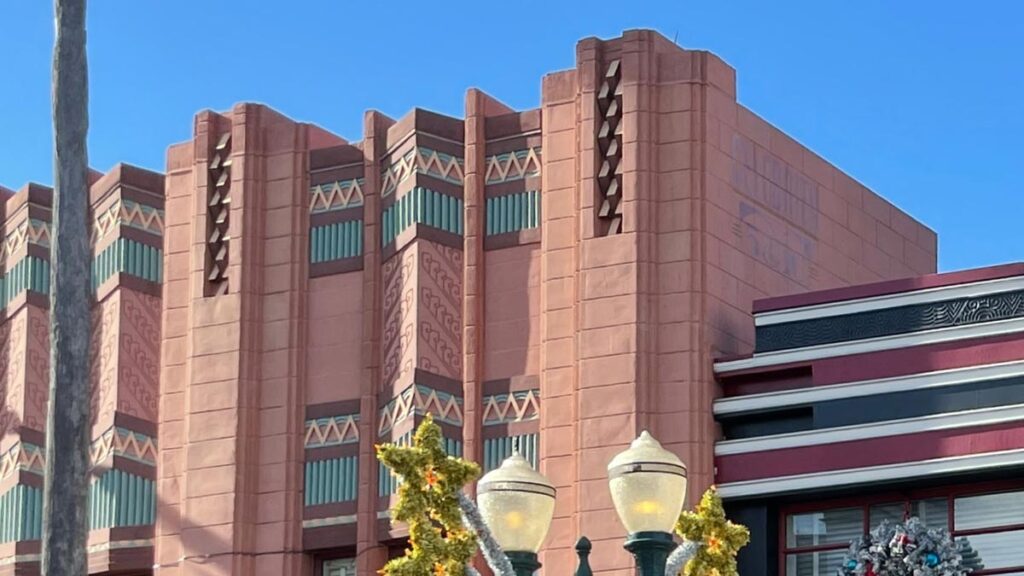
Secondly, the tops of the piers contain a fascinating 45-degree angled brickwork element, which forms the centerpiece of an otherwise classic Art Deco silhouette against the sky.
And lastly, there is a very clever trick being pulled on you with these decorative panels. As we’ve already discussed, the panels protrude from the facade, forming an accordion cleat of sorts. And at first glance, that is all it seems to be. But, if you look closer, you’ll see that the horizontal lines and bands that come across the panel are also sloping UPWARDS to that vertical line, and back DOWN on the other side in a upwards facing V shape. In other words, if you were able to float above the street so that you were looking straight at these panels, you’d find that these bands actually form a chevron shape, like an upward pointing arrow. They are NOT just running across in a straight line!
And what this does, from our viewpoint at the street, is to form an illusion of sorts (similar to the forced perspective trick used on many buildings at Disney World). It causes you to think that the panels are projecting even further out from the rest of the façade. The chevron trick serves to exaggerate the depth of the design.
Depth
Speaking of depth, I just want to point out to you how much Disney Imagineers pay attention to little details that make these façade designs so rich and believable.
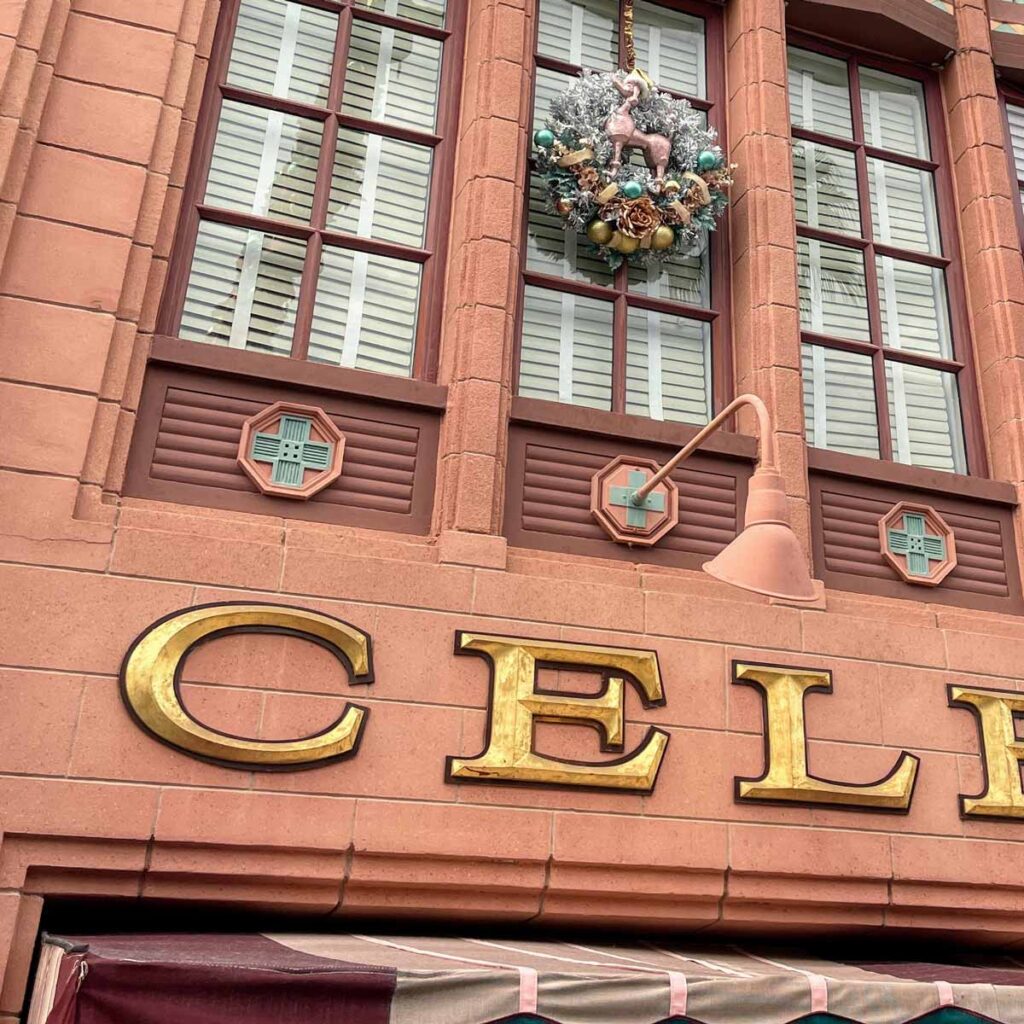
Look at the multi-layered brick returns at the windows and the storefront. These are more complicated and expensive details than just simply sticking a window in a wall. One of the hallmarks of buildings from this era (1920s-1930s Hollywood) is the exquisite detailing and the “art” of the architecture. This is one of the HUGE differentiators for Disney theme parks when compared to simple amusement parks, or even other theme parks. They immerse you in the theme of the land through detailing like this.
Conclusion
There’s not much more to say. I’m sure I’ll come across Disney architecture that I just can’t put my architect’s stamp on, but this one on Hollywood Boulevard ain’t it. Celebrity 5 & 10 is a unique Art Deco building that draws from the interest in art from exotic places of the 1920s and 1930s. Don’t miss it next time you’re at the Studios!
